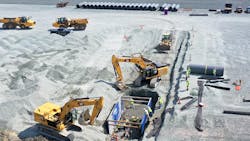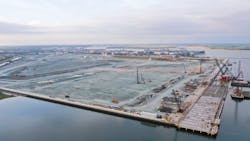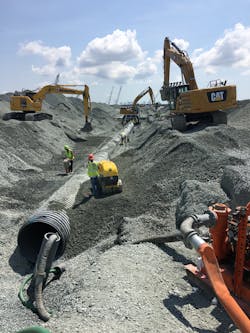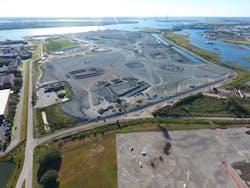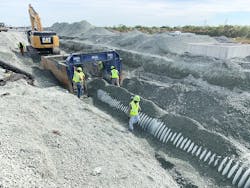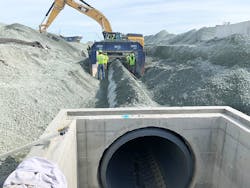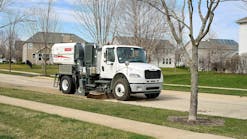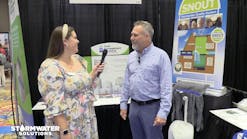Being built on the shore of the Cooper River in Charleston, S.C., the Hugh K. Leatherman Sr. Terminal had some 4.5 million metric tons of rock imported from Newfoundland to create a 23-foot elevation and the total site footprint of 248 acres. During the design phase, a prime concern for the engineers was the projected shifting of the rock due to the site and also the river’s currents. Upon review of new data, it was determined that the concrete pipe initially selected for the stormwater runoff system was not capable of providing the joint performance that was required to handle the anticipated settlement of the created site.
“One of the biggest issues was the very poor soil and the anticipation of as much as a foot of settlement after construction,” stated Stuart Timmons, P.E., water resources engineer for Infrastructure Consulting & Engineering PLLC (ICE; Columbia, S.C.). “The settlement of 12 inches over 25 years is not something that you typically see on a major infrastructure project like this one. That was definitely a key factor we were always designing around and looking at ways that would better suit those conditions. It was the number one challenge we had to overcome.”
The South Carolina Port Authority (SCPA) is building the terminal, which is the only permitted new container terminal on the U.S. Eastern and Gulf Coasts. Since receiving the final permit approvals in 2007, the Port has completed demolition, site preparation, containment wall construction and design activities for the first phase of the terminal on the Cooper River, site of the Charleston Naval Base from 1901 until 1996. The new terminal is on schedule to open in March 2021.
The Leatherman Terminal
Currently, the Leatherman Terminal is one of the top five largest construction projects in the state of South Carolina. The port is a key component of the SCPA plan to enhance economic development in the state and for the Southeast region of the United States. SCPA, established by the state’s General Assembly in 1942, owns and operates public seaport and intermodal facilities in Charleston, Dillon, Georgetown and Greer. As an economic development engine for the state, Port operations facilitate 225,000 statewide jobs and generate nearly $63.4 billion in annual economic activity.
Phase One construction of the terminal began in August 2019 and included the construction of the site improvements, buildings and canopies, the Port Access Road and Tidewater Road extensions, the wharf, and the purchase of five ship-to-shore cranes and 25 gantry cranes. The $700 million terminal will boost capacity in the Port by 50 percent. Another $300 million was spent to dredge the river to a depth of 52 feet to accommodate the draft of post-Panamax container ships, making it the deepest harbor on the East Coast.
“To limit the settlement at the site, the imported stone was brought in to surcharge the site via barges and ships to promote settlement before construction began,” Timmons explained. “Settlement has always been a huge driving force of this project. And so, when we started to think about the problems settlement could cause, we looked into using a flexible pipe system. That way as the site settled the pipe could move with it as opposed to a rigid pipe being affected by a shearing force with the differential settlement. With the poor soils and the higher groundwater, we recommended using polypropylene pipe. It’s a slightly stiffer pipe and better suited for the terminal’s conditions plus the joints for the polypropylene pipe are double gasketed."
According to Timmons, the idea was that with the settlement conditions anticipated, a double gasketed connection at the joints would help prevent any sort of separation and would be the best product for moving forward. "We presented this to the Port and they liked the idea. Also, the stone that was brought on site was perfect backfill material for the pipe. So, a lot of things just fell into place that made the polypropylene pipe the most suitable option for our stormwater system.”
In order to mitigate joint separation and possible exfiltration and even infiltration, Timmons and his team specified HP Storm Polypropylene Pipe from Advanced Drainage Systems Inc. (ADS) as the storm drain conveyance pipe for the entire project. This was due to secure joint performance, the pipe’s inherent ability to flex with the soil, and its ability to provide strength while also being easy to handle.
Rapid completion of each portion of the project was critical because a delay on one part would cause a rippling effect of delays all through the site. Using ADS HP Storm pipe enabled Banks Construction Company (North Charleston, S.C.) to stay on the aggressive construction schedule by saving months of install time versus the time and manpower that would have been needed for concrete box culverts and pipe.
“Banks estimated that HP Storm pipe could be installed twice as fast as conventional concrete drainage products,” reported Daniel Currence, P.E., director of engineering for the Drainage Division of the Plastics Pipe Institute. “In fact, using two seven-man crews, they reported averaging 160 feet a day of 60-inch diameter pipe, and nearly 300 feet a day for 18- to 30-inch diameter pipe, for example. This is a high-performance polypropylene pipe for gravity-flow storm drainage applications that couples polypropylene resin technology with a dual-wall profile design for superior performance and durability. The smooth interior wall offers additional strength as well as a high rate of water flow.”
Port Expansion Project Wins Industry Honor
Due to its size and the solution for the complex situation, the undertaking was named Project of the Year for the Drainage Division of the Plastics Pipe Institute Inc. (PPI), the major North American trade association representing all segments of the plastic pipe industry. The association’s annual awards program recognizes projects and members for exceptional contributions to the industry. Submissions in the association’s divisions are reviewed, evaluated and voted upon by the PPI members.
“The use of polypropylene pipe at the new terminal shows the benefits of plastic pipe over traditional materials,” stated David Fink, president of PPI, when he presented his association’s award to ADS. “This project is the premier privately funded project in the State of South Carolina. It demonstrates to every contractor and engineer about the benefits plastic pipe can provide for their jobs, especially DOT roadway construction projects. ADS HP Storm has exceeded the expectations for installation, durability and schedule.”
The HP Storm polypropylene pipe meets ASTM F2736, ASTM F2881 and AASHTO M330 for the respective diameters and is approved for use by the Army Corps of Engineers for storm drainage applications. The pipe has an extended, reinforced bell with a polymer composite band and gaskets that add an additional factor of safety within each joint. The joint performance meets or exceeds the 10.8 psi laboratory performance standards per ASTM D3212 requirements. The ADS plant in Bessemer City, N.C., manufactured the pipe. The company has a network of 63 strategically located local plants and 32 distribution centers.
The terminal’s storm drain system, designed for a ten-year storm, needs to carry runoff for more than a mile with minimum slope of 0.33 percent to the containment pond. It also had to be able to withstand live and dead loads that would be greater than an average highway project. In addition to other heavy equipment typically found at a container terminal, a loader container handler, for example, is rated at nearly 92,000 pounds per axle. Specific minimum cover was determined in order to compensate for flotation due to the high groundwater level as well as the live and dead loads that would be present on the site.
“The design loading calculations were for vehicles that aren’t typically what you’d use on a standard highway job or site job,” Timmons said. “We had vehicles that would be used at the terminal with design loads beyond anything I had worked with on previous projects. The empty container handlers along with the Bombcarts produced some of the larger loads on the pavements and were used to ensure sufficient cover was provided for the storm drain pipes. There was a lot of coordination with ADS engineers on the appropriate design load to use, and we proceeded with the ADS spec for railway applications.”
Geosynthetic fabric was used over the pipe bedding and run up the sides of the trench to help deal with the overall settlement of the site. This will also help to prevent migration of fines from the ballast stone and screened materials. Geogrid was used to provide support to counter differential settlement.
“If we were getting into the softer, silty material,” Timmons offered, “we placed geogrid underneath the pipe to reinforce the soil conditions a little bit and limit the amount of settlement that would occur underneath the pipe. Using geogrid as a sub-bed under the pipe and also underneath the stormwater boxes improved the trench conditions of the pipe before we backfilled with the on-site stone.”
The state-of-the-art terminal will have both electric and hybrid equipment that will ensure efficient operations while reducing emissions. Phase One will house the tallest ship-to-shore (STS) cranes at the Port of Charleston with five cranes having a 169-foot lift height, as well as 25 new hybrid rubber-tired gantry (RTG) cranes.
The Leatherman Terminal, named for Hugh K. Leatherman, who has served as a South Carolina State Senator since 1980, will be built in phases during the next decade. When completed, the terminal will have three berths capable of handling 2.4 million TEUs of cargo, doubling the port’s existing throughput capacity. SW
Steve Cooper has reported on water industry projects for several decades, conducting interviews with professional engineers, contractors, government officials and representatives of major companies supplying the industry.
